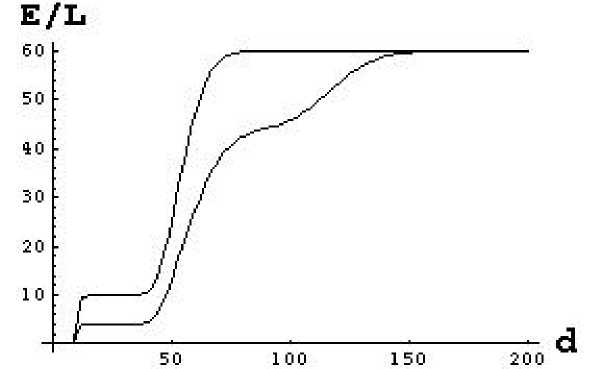(2.3)
∞ ∞
R[d] ʃ^ a [pr] ∫Ψ[ w] dwdpr
0 W [pr,d]

Figure 6
Fractions of Employment/Labor as a
function of traveling distance d to CBD
The possibility of multipurpose
shopping represents a centripetal force
that attracts customers to the city
center. Figure 6 illustrates the effect of
this force. The upper curve refers to a
situation where only one type of good
is considered. The lower curve
indicates how the propensity to do their shopping locally is reduced for customers with residence
outside the city center.
Using the set of ideas above, we are also able to include various other effects in our model. One such
aspect is an increased willingness to travel to the CBD during weekends, which may partly be
explained through a tendency to put less weight on the time consumption part in this case. Any
particular service may be split into 7 daily services, the time component part can be allowed to vary
on a daily basis. The local sector activities are then reproduced using a weighted average of the
expression (2.3).
If we interchange the order of integration in (2.3), we get
(2.4)
R [ d] ɪʃ ʃwΦ ( pr) dpr Ψ( w) dw
00
where TC=TC[w,d] is the generalized traveling cost for traveling a distance d when the wage level is
w . Differentiating this expression, we see that
(2.5)
R'[d] = ʃΦa (TC[ w, d]) aTCj w, d] dprΨ(w) dw
I a^ ∂d
If we assume that the mapping d→ TC[w,d] is linear or more generally concave, we get
(2.6)
∞
2._____
dpr Ψ( w) dw
R''[d] ≤∫Φa(TC[w,d])PTj.V, ]
о < ad
More intriguing information
1. Optimal Rent Extraction in Pre-Industrial England and France – Default Risk and Monitoring Costs2. Institutions, Social Norms, and Bargaining Power: An Analysis of Individual Leisure Time in Couple Households
3. The name is absent
4. The name is absent
5. Inflation Targeting and Nonlinear Policy Rules: The Case of Asymmetric Preferences (new title: The Fed's monetary policy rule and U.S. inflation: The case of asymmetric preferences)
6. Learning-by-Exporting? Firm-Level Evidence for UK Manufacturing and Services Sectors
7. The name is absent
8. The name is absent
9. Short Term Memory May Be the Depletion of the Readily Releasable Pool of Presynaptic Neurotransmitter Vesicles
10. Manufacturing Earnings and Cycles: New Evidence